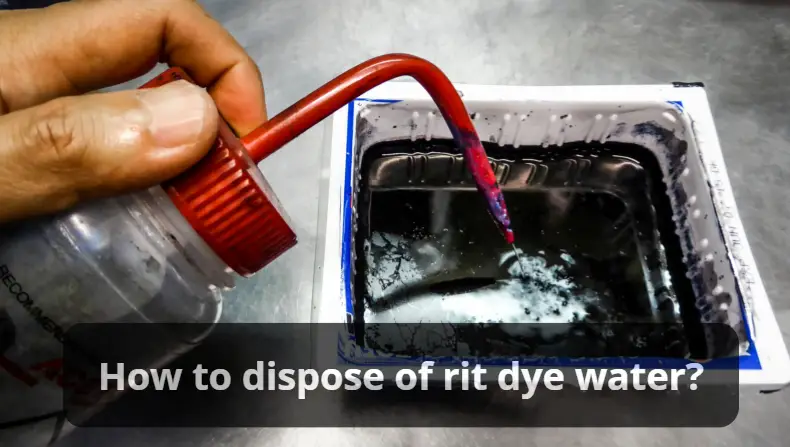How to dispose of rit dye water?
Rit dye, a versatile and widely-used fabric coloring agent, offers a spectrum of colors for various dyeing projects. However, proper disposal is crucial to circumventing any environmental impact. This guide elucidates the safest methods to dispose of Rit dye to ensure that it neither contravenes local regulations nor poses a risk to the environment or human health.

Step-by-Step Safe Disposal of Rit Dye
Before disposing of Rit dye, always refer to the product’s label for any manufacturer-specific directives. The process of Rit dye disposal encompasses preparation, execution, and the final phase of testing to ensure your environmental footprint remains minimal. Here’s how to approach it effectively:
Preparing Your Disposal Kit
Gather all requisite materials for a well-organized disposal process. This includes a pH testing kit to gauge the acidity or basicity of the solution and materials such as baking soda or citric acid crystals to adjust the pH level of the dye. Preparation prior to beginning the process saves time and facilitates a more streamlined procedure.
Donning Personal Protective Equipment (PPE)
To guarantee personal safety, equip yourself with the right PPE, consisting of gloves, a long-sleeved shirt, goggles, and a dust mask. These items protect your skin, clothing, eyes, and respiratory system from accidental exposure to the dye and its particles, which might lead to health complications.
Selecting an Optimal Disposal Location
Opt for a well-ventilated area free from any household food items to prevent contamination. The space should be secured against interference from children, pets, or any household members to eliminate the risk of accidental exposure or interruptions.
Preparing the Workspace
Safeguard your workspace by covering surfaces with paper towels or an equivalent absorbent material. This acts as the first line of defense, capturing any spills and making cleanup more manageable.
Neutralizing the Rit Dye
Modulate the pH level of Rit dye, ensuring it approximates that of water, which is neutral (pH 7). Convert powder dye into liquid form if necessary and methodically add baking soda to acid dyes or citric acid crystals to basic dyes, adjusting the substance towards a neutral pH.

Validating the pH Level
Employ pH testing strips after each adjustment to accurately measure the altered pH level. These handy tools will indicate how close you are to reaching the neutral target and when the adjustment process is complete.

Final Disposal
Once the Rit dye is satisfactorily neutralized, you can confidently dispose of the substance by pouring it down the drain. Ensuring that the dye is pH-neutral before disposal significantly mitigates any environmental repercussions.

Where else can you use the dye after use?
Advanced Techniques for Safe Disposal of Fabric Dyes
While the basic steps outlined above provide a solid framework for disposing of Rit dye safely, a few advanced techniques can further enhance the safety and environmental soundness of the disposal process.

Precise pH Adjustment Tailored to Your Dye Type
Not all dyes have the same pH level, and as such, each requires a tailored approach to neutralization. For precise adjustment, a detailed understanding of the specific dye type and its corresponding pH level is needed. Use the pH testing kit to continuously monitor the changes as you incrementally add neutralizing agents.
Disposal Methodology for Different Dye States
Depending on whether the Rit dye is in liquid or powder form, the procedure for disposal slightly varies. For powdered dyes, it is particularly important to dissolve the dye in water and neutralize it before disposal. This ensures that any airborne particles are minimized, enhancing the safety of the process.
Implement Eco-Friendly Disposal Enhancements
Explore environmentally-friendly agents for neutralization, such as natural baking soda for acidic dyes. This doesn’t only neutralize the pH but also minimizes the chemical load entering the wastewater system.
Emergency Spill Management
In case of a spill during the disposal process, be prepared with a spill management plan. This involves immediate containment and cleanup, using absorbent materials like sand or organic compounds to immobilize the dye and prevent it from spreading.
Proper PPE Disposal
After completing the disposal of the Rit dye, ensure that the used PPE is discarded in a way that doesn’t pose a threat to sanitation workers or the environment. Contaminated gloves, masks, and other items should be placed in a sealed bag before putting them in the trash.

Conclusion
Upon concluding the disposal process, remove and dispose of your protective apparel responsibly. Be thorough in washing your hands before resuming your daily activities. Safeguarding the environment and protecting personal well-being is not only a personal responsibility but a collective duty to future generations.
Adherence to these detailed steps will not only yield a safe and efficient disposal process but will also reflect a commitment to environmental stewardship and personal safety.
For further exploration into safe disposals, check out our comprehensive articles on various waste management topics, such as Top 6 Recommendations on how to dispose of lamp oil safely.
FAQs
Can I pour Rit dye water down my sink?
If you are connected to a municipal sewage system, you can usually pour diluted Rit dye down the drain. However, it’s important to check local regulations first.
Is Rit dye safe for septic systems?
Rit dye may not be septic-safe because it can interfere with the system’s ability to break down solids. Always consult with septic system guidelines before disposal.
Can I throw Rit dye water in my garden?
No, it’s not a good idea because the chemicals can negatively impact soil and plants.
Are there eco-friendly dyes that I can use instead of Rit dye?
Yes, there are biodegradable and natural dyes available on the market that are considered more eco-friendly.

